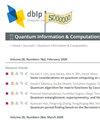快速导航与二十面体金门
IF 0.7
4区 物理与天体物理
Q3 COMPUTER SCIENCE, THEORY & METHODS
引用次数: 0
摘要
Ross和Selinger将PU(2)的对角线元素分解到距离$\varepsilon$内的算法被Parzanchevski和Sarnak采用为PU(2)的任何元素的有效概率算法,该算法使用与数字域和素数$p$相关的某些精心选择的集合中的最有效$3\log_p\frac{1}{\varepsilon^{3}}$因子。二十面体超级金门就是与$\mathbb{Q}(\sqrt{5})$相关的一组。我们利用Carvalho Pinto, Petit和Stier最近的工作将这个界限降低到$\frac{7}{3}\log_{59}\frac{1}{\varepsilon^3}$,并在Python中实现该算法。这表示与Clifford+ $T$门的类似结果相比,有了$\log_259\approx5.9$倍的改进。这是有趣的,因为二十面体门是所有超级金门中分解长度最短的。本文章由计算机程序翻译,如有差异,请以英文原文为准。
Fast naviation with icosahedral golden gates
An algorithm of Ross and Selinger for the factorization of diagonal elements of PU(2) to within distance $\varepsilon$ was adapted by Parzanchevski and Sarnak into an efficient probabilistic algorithm for any element of PU(2) using at most effective $3\log_p\frac{1}{\varepsilon^{3}}$ factors from certain well-chosen sets associated to a number field and a prime $p$. The icosahedral super golden gates are one such set associated to $\mathbb{Q}(\sqrt{5})$. We leverage recent work of Carvalho Pinto, Petit, and Stier to reduce this bound to $\frac{7}{3}\log_{59}\frac{1}{\varepsilon^3}$, and we implement the algorithm in Python. This represents an improvement by a multiplicative factor of $\log_259\approx5.9$ over the analogous result for the Clifford+$T$ gates. This is of interest because the icosahedral gates have shortest factorization lengths among all super golden gates.
求助全文
通过发布文献求助,成功后即可免费获取论文全文。
去求助
来源期刊

Quantum Information & Computation
物理-计算机:理论方法
CiteScore
1.70
自引率
0.00%
发文量
42
审稿时长
3.3 months
期刊介绍:
Quantum Information & Computation provides a forum for distribution of information in all areas of quantum information processing. Original articles, survey articles, reviews, tutorials, perspectives, and correspondences are all welcome. Computer science, physics and mathematics are covered. Both theory and experiments are included. Illustrative subjects include quantum algorithms, quantum information theory, quantum complexity theory, quantum cryptology, quantum communication and measurements, proposals and experiments on the implementation of quantum computation, communications, and entanglement in all areas of science including ion traps, cavity QED, photons, nuclear magnetic resonance, and solid-state proposals.
 求助内容:
求助内容: 应助结果提醒方式:
应助结果提醒方式:


